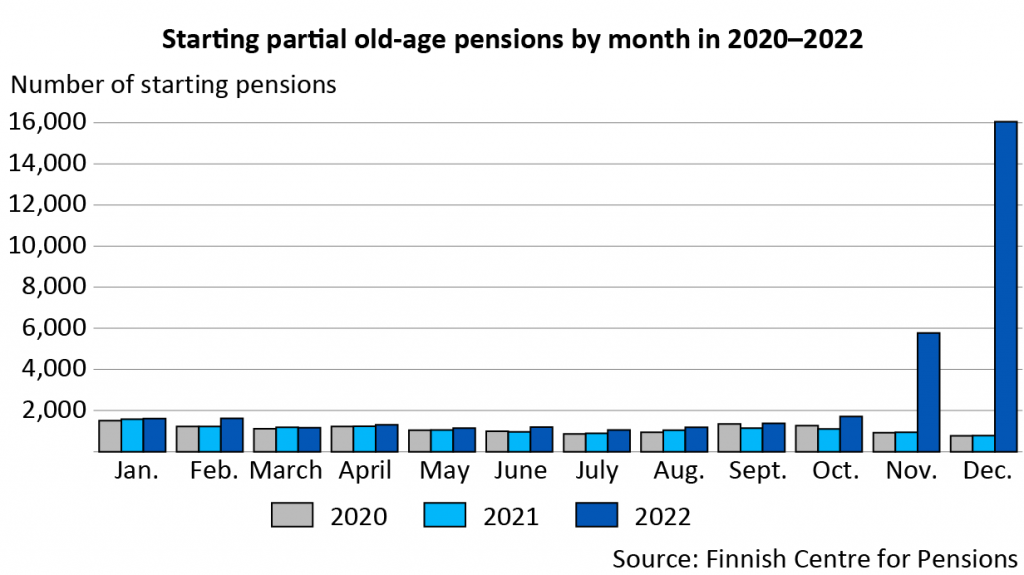Unusual index increase led to a flood of pension claims

The number of pension claims soared at the end of 2022 as tens of thousands of Finns claimed the partial old-age pension. Exceptionally, the increase in the earnings-related pension index was clearly higher than the increase in the wage coefficient. It encouraged people to claim the pension already in 2022.
Nearly 25,000 Finns claimed a partial old-age pension in September-December 2022. During the same period in 2021, the number of people claiming the pension was more than 4,000. The figures are from recent statistics of the Finnish Centre for Pensions.
The strong growth in claims shows also in the number of starting pensions. For example, in December 2022, around 16,000 new partial old-age pensions started. The number is 20 times higher than in December 2021 and 2020. All-in-all, a total of 34,600 partial old-age pensions started in 2022. In the two previous years, new partial old-age pensions have numbered around 13,000 per year.
Most of the claimants for the old-age partial pension in December 2022 were clearly older than those usually claiming this pension. As a result, the starting pensions were larger than before. “A 50-per-cent partial old-age pension that started in December was, on average, 900 euros per month. This is an amount that is around 20 per cent higher than in December 2021”, says Development Manager Jari Kannisto (Finnish Centre for Pensions).

Table: The monthly statistics on new retirees on earnings-related pensions in 2022, by month
The number of regular old-age pension claims was also higher in 2022 than before. The rise in claims occurred in the autumn, bringing the number of old-age pensions starting in December to three times the normal level.
Pension starting in December 2022 higher than pension starting in January 2023
The main reason underlying the flood of claims at the end of 2022 was the exceptional effect of the pension index on pension amounts. If the pension started in December 2022, it was increased immediately in January 2023 by 6.8 per cent. If the pension started in January 2023, the annual earnings that the pension is based on was increased to the level of the starting year by the wage coefficient. The wage coefficient rose by 3.8 per cent, which is three per cent less than the earnings-related pension index. This means that a pension starting in January 2023 is smaller than one that started in December 2023.
“As a rule, the wage coefficient increases more than the pension index. This time, it was the other way around, and the difference was significant. By starting to draw the partial old-age pension in December 2022, it was possible to take advantage of this unusually high increase in the earnings-related pension index,” Kannisto explains.
Additional income comes with a price
A person claiming a partial old-age pension can select to draw either 25 or 50 per cent of the pension they have accrued so far. Most select to take out 50 per cent of their accrued pension.
The additional income comes with a price, though, as taking out the partial old-age pension reduces the final, full old-age pension.The partial old-age pension is cut by 0.4 per cent for each month that the pension is taken out early, from taking out the pension to reaching one’s retirement age. However, in this exceptional index situation, the index increase at the turn of the year compensates several months of the cut in the pension for early retirement.
“If a person continues working as before after taking out the partial old-age pension at the end of the year, the income increase leads to a higher tax rate. It’s good to know that it is also possible to cancel the partial old-age pension within three months from starting to take it out”, Kannisto points out.
Indexes in a nutshell
- Two indexes affect earnings-related pensions: the earnings-related pension index and the wage coefficient.
- The earnings-related pension index is used to raise pensions in payment. At the time of retirement, the wage coefficient adjusts career lifetime earnings to the level of the year in which the pension begins.
- Both indexes are adjusted annually in January. The earnings-related pension index rose by 6.8 per cent and the wage coefficient by 3.8 per cent at the beginning of 2023. The high increase in the earnings-related pension index is due to high inflation.
Example of effect of index: retire on an old-age pension in December 2022 or January 2023
- In this example, the person reaches their retirement age in November 2022 and has accrued a monthly pension of 1,500 euros by the beginning of December 2022. The person is not working in retirement. If they retire on an old-age pension in December 2022, they will get an increment to their pension in January 2023 based on the earnings-related pension index. After this, their monthly old-age pension is 1,602 euros.
- If a person retires on an old-age pension in January 2023, their previous earnings will be multiplied with the wage coefficient to the 2023 level when their pension amount is calculated. The monthly wage of the person in this example was 3,000 euros, which means his starting old-age pension in January was 1,567 euros per month.
- The person retiring in December 2022 will get a monthly pension that is 35 euros higher. Per year, this is around 420 euros more that for the person who retires in January 2023.
